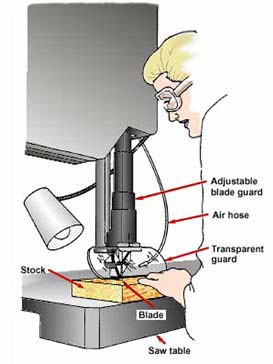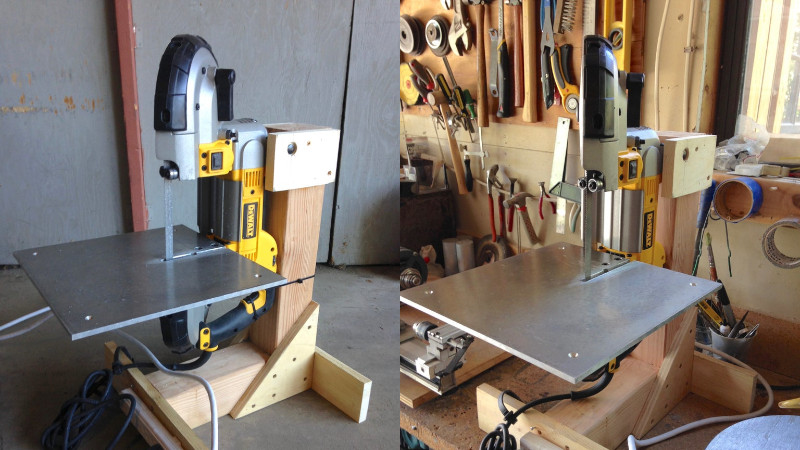Do you enjoy working with power tools? If so, you’ve probably heard of the mighty bandsaw. But where exactly should you stand when operating this powerful machine? Well, my friend, in this article, we’ll dive into the crucial question: “Where do you stand when operating a bandsaw?”
Using a bandsaw can be thrilling, but safety should always come first. So let’s talk about the ideal position. Picture this: you’re facing the bandsaw, feet shoulder-width apart, and positioned slightly to the side. This way, you have a clear view of the blade and can easily guide the material through.
Now that we’ve got the basics covered, let’s explore some safety tips and best practices to ensure a smooth and accident-free bandsaw experience. So, are you ready to learn more about this essential woodworking tool? Let’s get started!

Where Do You Stand When Operating a Bandsaw?
When it comes to operating a bandsaw, one of the most important considerations is your positioning and stance. Knowing where to stand when using this powerful tool is crucial for your safety and the efficiency of your work. In this article, we will explore the different aspects of where to position yourself when operating a bandsaw, discussing the ideal stance, safety precautions, and tips for maximizing your productivity. Whether you’re a beginner or an experienced woodworker, understanding the correct positioning will help you enhance your craftsmanship and minimize the risk of accidents.
The Ideal Stance: Safety and Precision
Having the right stance while operating a bandsaw is vital for both safety and precision. The ideal position is to stand with your feet shoulder-width apart, ensuring a stable base. This stance allows for better control over the materials being cut and minimizes the risk of losing balance. Distributing your weight evenly on both feet will provide balance and prevent any unexpected movements that can lead to accidents.
Additionally, position yourself in a way that gives you a clear view of the cutting line and the blade. This will enable you to make accurate cuts and avoid any potential mistakes. Remember to keep your body aligned with the direction of the cut, ensuring that your hands are positioned comfortably on the material while maintaining a safe distance from the blade.
It’s also important to maintain good posture throughout the process. Stand up straight and avoid leaning or bending over the bandsaw. This will not only prevent strain on your back and neck but also allow you to have better control over the tool.
The Importance of Safety Precautions
Operating a bandsaw can be potentially dangerous if proper safety precautions are not followed. In addition to the correct stance, there are other vital safety measures to keep in mind:
- Wear appropriate safety gear, including safety glasses, ear protection, and gloves. These will protect you from flying debris and reduce the risk of injuries.
- Keep the work area clean and free from clutter. This will help prevent any accidents caused by tripping over objects or getting entangled in them.
- Make sure the bandsaw is properly maintained and in good working condition. Regularly check the blade tension, blade alignment, and all safety features to ensure safe operation.
- Never force the material through the blade. Let the blade’s teeth do the cutting, applying gentle and steady pressure. Forcing the material can lead to kickback or blade breakage.
- Always disconnect the bandsaw from the power source when not in use or during blade changes. This will prevent accidental starts and unauthorized use.
Tips for Maximizing Productivity
Now that we’ve covered the ideal stance and safety measures, let’s explore some tips for maximizing productivity when operating a bandsaw:
- Choose the right blade for the specific type of cutting you need to do. Different blades are designed for various materials and cuts. Consult the bandsaw’s manual or seek advice from experts to select the most appropriate blade.
- Feed the material into the blade at a steady pace, avoiding sudden movements that can put strain on the blade or cause it to deviate from the desired cut line.
- Use guides and fences to ensure accurate cuts. These accessories can help maintain a straight line during cutting and produce precise results.
- Practice patience and take your time. Rushing can lead to mistakes and compromise the quality of your work. Remember, precision and safety go hand in hand.
- Regularly clean and lubricate the bandsaw to maintain its performance and extend its lifespan. Proper maintenance will ensure smoother cuts and prevent any issues that may arise from a neglected machine.
Choosing the Right Bandsaw for Your Needs
When it comes to operating a bandsaw, having the right tool for the job is essential. Different bandsaws come with varying features and capabilities, and choosing the right one will greatly impact your work quality and efficiency. Here are a few factors to consider when selecting a bandsaw:
Power and Cutting Capacity
Ensure that the bandsaw’s motor has enough power to handle the type of materials you’ll be cutting. Pay attention to the cutting capacity of the bandsaw as well, considering the maximum throat depth and height it can accommodate. This will determine the size and thickness of the materials you’ll be able to work with.
Blade Type and Tensioning
Consider the types of blades that can be used with the bandsaw and the ease of changing or tensioning them. Different blade widths, tooth patterns, and materials are suited for different cutting tasks, so having flexibility in blade options will expand your capabilities.
Table and Fence Adjustability
Look for a bandsaw with an adjustable table and fence. Being able to tilt the table and adjust the fence position allows for bevel cuts and precise angle adjustments, enhancing the versatility of the tool.
Conclusion
Knowing where to stand when operating a bandsaw is crucial for your safety, precision, and efficiency. By adopting the ideal stance, following safety precautions, and implementing productivity tips, you can maximize your woodworking experience and create high-quality projects. Additionally, selecting the right bandsaw for your needs will further enhance your capabilities. Remember to always prioritize safety, maintain your equipment, and continuously improve your skills to achieve the best possible results.
Key Takeaways: Where Do You Stand When Operating a Bandsaw?
- 1. Always stand to the side of the bandsaw, not in front or behind it.
- 2. Position yourself so that you have a clear view of the cutting area and the blade.
- 3. Keep a safe distance from the blade, maintaining at least 6 inches of clearance.
- 4. Ensure that your feet are firmly planted on the ground and maintain a stable stance.
- 5. Avoid reaching over the bandsaw blade or standing on an unstable surface while operating the machine.
Frequently Asked Questions
Here are some common questions about operating a bandsaw:
1. What is the ideal standing position when operating a bandsaw?
When operating a bandsaw, it is recommended to stand to the side of the machine, slightly offset from the cutting line. This position provides a clear view of the blade and workpiece, allowing you to make accurate cuts safely. Standing to the side also minimizes the risk of injury in case of any unexpected kickbacks or material ejection.
Never stand directly in line with the blade or directly behind the workpiece, as this can put you in the path of potential danger. By standing to the side, you can maintain better control and avoid any potential accidents.
2. Is there a specific distance I should maintain between myself and the bandsaw?
Yes, it is essential to maintain a safe distance from the bandsaw while operating it. A general rule of thumb is to keep at least two feet of space between yourself and the machine. This distance ensures that you have enough room to maneuver and react in case of any unexpected events.
By maintaining a safe distance, you reduce the risk of getting too close to the blade or being injured by any flying debris. Always prioritize your safety and be aware of your surroundings when operating a bandsaw.
3. Should I wear any protective equipment when using a bandsaw?
Absolutely! It is crucial to wear appropriate protective equipment when operating a bandsaw. This includes safety goggles or a face shield to protect your eyes from any flying debris, such as wood chips or metal shavings. Gloves can also provide an additional layer of protection and improve your grip on the workpiece.
Additionally, wearing ear protection is highly recommended, as bandsaws can produce loud noise levels that may be harmful to your hearing over time. Always prioritize your safety and make sure you have the necessary protective gear before using a bandsaw.
4. Can I use a bandsaw if I am under 18 years old?
The use of a bandsaw by individuals under 18 years old should strictly follow the guidelines and regulations set by your local authorities or educational institutions. In some places, there may be age restrictions or requirements for supervision when using power tools, including bandsaws.
To ensure the safety of young individuals, it is crucial to provide proper training, supervision, and adhere to any legal requirements. If you are underage and interested in using a bandsaw, consult with a responsible adult or your educational institution to understand the necessary precautions and guidelines.
5. Are there any specific safety tips I should keep in mind when operating a bandsaw?
Absolutely! Here are a few essential safety tips to remember when using a bandsaw:
First, always read and follow the manufacturer’s instructions and safety guidelines provided with the bandsaw. These guidelines will give you specific information about the machine and its safe operation.
Second, ensure the bandsaw is properly adjusted and maintained, including checking the blade tension, tracking, and alignment. A well-maintained machine reduces the risk of accidents and produces better results.
Third, never force or rush the cuts. Allow the bandsaw to do the work at its own pace, ensuring a smooth and controlled operation. And remember, always concentrate and focus on the task at hand without any distractions.
Finally, keep the bandsaw area clean and free of debris. Clear away any offcuts, sawdust, or other potential hazards that could interfere with your work or compromise your safety.

Summary
Operating a bandsaw requires caution to prevent accidents and ensure safety. Always stand to the side of the cutting line to avoid injury.
Remember to use proper cutting techniques and keep your hands away from the blade. Safely operating a bandsaw is essential for a smooth and accident-free woodworking experience.